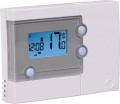Suitable for
The type of equipment for which the regulator is suitable.
Modern thermostats and automation systems can be used for:
- For different types of boilers —
gas,
electric,
solid fuel.
- For
heaters and underfloor heating - for both at the same time: the control features in both cases are very similar, which makes it easy to combine them in one device.
- For
pumps — namely for circulation pumps of heating systems.
— For
heat pumps. A heat pump provides heat transfer from the environment to the room, providing heating. (Air conditioners work on a similar principle, but their main task is cooling).
— For
fancoils. A fancoil is a device that cools or heats air by passing it through a system of pipes with a coolant circulating through them. And for the necessary heating or cooling of the coolant, another component of the system is responsible - a chiller, usually installed outdoors. A feature of such climate systems is that most of them can be used not only for heating in the cold season but also for cooling in the hot season.
— For
outdoor system. Regulators for various climatic equipment installed outdoors. These can be, for example, anti-icing systems, devices f
...or heating pipelines, chillers for chiller-fan coil systems, etc.
In many models, several options are combined at once; for example, most devices for electric boilers are quite compatible with gas boilers.
In any case, it is the first criterion that one should pay attention to when choosing.Max. load
The maximum load in terms of current power that the thermostat can withstand. In other words, the maximum electrical power that it can pass through itself without failures and damage.
The choice for this parameter directly depends on the power consumed by the boiler or heater connected through the thermostat; load limitation is of particular importance when working with electric boilers, the energy consumption of which is measured in kilowatts. When connected directly, the power of the heater should not exceed the maximum load of the thermostat, otherwise the latter will simply fail. However, when using additional protective devices (contactors), many models allow connection to a more powerful load than originally allowed.
Temp adjustment range
It is the range in which the air temperature can be set on the regulator. The choice for this indicator depends on the expected conditions in the room. So, in a residential building, the lower temperature limit at the level of 5–10 °C is quite sufficient; the upper limit is within 30–40 °C (regardless of whether we are talking about air or floor temperature). But in control devices designed for industrial use, this range will be much wider — from sub-zero temperatures to the upper limit of 100 – 125 °C.
Air temp sensor
The presence
of an air temperature sensor in the design or delivery set of the controller — such a sensor can be either built into the device or external.
Air temperature is one of the key parameters that determine the climate in the room and the comfort of staying in it. Accordingly, the air temperature sensor allows the regulator to evaluate the general conditions in the room and control the heating operation, taking into account how the microclimate corresponds to the desired one. However, note that such sensors are not always applicable. For example, in kitchens and bathrooms, they may not work correctly (when hot water, a gas stove or a water heater is turned on, etc.), so in such conditions it is better to use floor temperature sensors (see below).
Programmable cycles per day
The largest number of individual cycles that the thermostat timer can set in one day.
The cycle is the period during which the thermostat operates on one set of settings. For example, if there are 2 cycles, you can provide turning off the heating while you are at work and turn it on shortly before returning home. However, most thermostats provide a noticeably larger number of cycles — up to 24.
Note that in weekly timers (see "Timer type") this parameter may differ depending on the day of the week. For example, weekdays usually have more extensive settings than weekends.
Minimum increment
The shortest duration a programmable thermostat cycle can have (see "Programmable cycles per day").
The lower this parameter (with the same number of cycles per day) — the wider the possibilities for programming the operation of the thermostat, in particular, for its specific setting (for example, you can provide a short period of preliminary "intensive heating" after working at low temperatures). On the other hand, due to a certain inertia in the operation of heating systems, it makes no sense to make an interval shorter than 10 minutes — the thermostat simply does not have time to work out the specified settings in less time. And in the most "long" models, this parameter is about 30 minutes.

